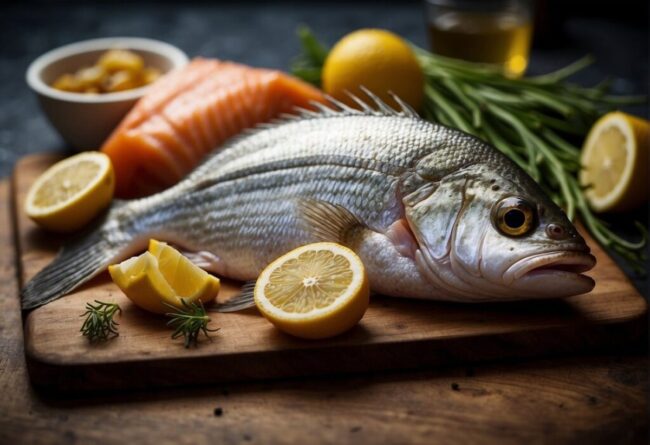4 Best Fish to Use Instead of Snapper
Snapper substitutes allow seafood lovers to enjoy mild, slightly sweet flavors when this fish isn’t available.
Certain alternatives hold up well to grilling and baking, while others flake apart beautifully.
The right choice makes sure dishes stay fresh, tender, and well-balanced.
Cooking seafood still feels effortless with a perfectly matched swap.
Understanding Snapper
Different types of snapper provide unique flavors and textures that enhance various dishes.
Red snapper, known for its mild, nutty taste with a hint of sweetness, is especially popular in the Gulf of Mexico.
Queen snapper offers a lighter flavor while vermilion snapper shares similarities with red but is usually smaller and sweeter.
Mutton snapper stands out for its firmer texture and stronger taste.
Abundant in structured areas like reefs, snappers thrive on diets rich in crustaceans and smaller fish which add to their distinct flavor profile.
For cooking options, grilling or baking allows this fish to shine beautifully across many recipes; alternatives can be chosen when necessary to maintain the intended taste and texture.
Best Snapper Replacements
Top snapper substitutes offer mild and firm-textured fish that fit a range of dishes. They provide a versatile replacement for grilling, frying, and baking.
Mild and Flexible White Fish
Cod serves as a versatile option, known for its slightly firmer texture and wide availability.
Haddock, closely related to cod, features a delicate flake with a mild flavor.
Tilapia shines as an affordable choice with its lighter flake and subtle taste.
Sea bass impresses with its buttery richness, perfect for creating elevated dishes that stand out on any menu.
Grouper resembles snapper in sweetness and can easily replace it in various recipes.
Bolder Taste Choices
Flounder offers a lighter choice, ideal for dishes needing thin, delicate fillets.
Catfish stands out with its firmer texture and robust river flavors.
Halibut features a dense flesh that readily takes on marinades and spices, enhancing its taste.
Each fish provides unique qualities to elevate any meal.
Enjoying the different textures and flavors can lead to exciting culinary experiences that cater to various preferences.
Hearty Textured Options
Mahi-Mahi offers a firm texture and a flavorful profile, making it an excellent choice in tropical dishes where snapper is typically used.
Rockfish thrives in similar environments as snapper, delivering a wild ocean taste that seafood lovers appreciate.
For those seeking something heartier, tuna steak serves as a robust alternative for bolder recipes.
These fish options not only provide variety but also enhance the culinary experience with their distinctive flavors and textures.
Options for Freshwater
Trout offers a flaky texture that closely resembles snapper, making it an excellent choice for substitution.
It usually thrives in freshwater and can be seasoned effectively to mimic the flavors of snapper.
Keeping the original essence of snapper is important when using trout; selecting the right seasonings and cooking techniques will help achieve this goal.
A common ratio for recipes is 1:1, though personal taste and specific traits of trout may require adjustments.
Enjoying this fish opens up versatile cooking options while still capturing delightful flavors in your dish.
Finding Substitutes by Texture and Flavor
Finding substitutes by texture and flavor ensures a well-balanced dish. Some options provide a sharp, tangy taste, while others offer a creamy, mild profile.
Gentle Taste Alternatives
Rockfish stands out with its sweet flavor and tender, flaky texture.
This fish adapts well to many dishes because it absorbs seasonings beautifully.
Tilapia is another excellent choice, featuring a mild taste that blends effortlessly into recipes where snapper is used.
Its easy cooking method makes tilapia a popular option for those seeking quick meal solutions.
Both of these fish provide versatility in the kitchen while enhancing the overall dish experience without overpowering other ingredients.
Ideal for various preparations, they offer delicious alternatives to traditional snapper in your meals.
Hearty Meat Substitutes
Sea bass offers a rich and mild taste, making it an excellent alternative to snapper.
Its firm and meaty texture adapts well to many cooking styles, allowing versatility in the kitchen.
Grouper shares a similar robustness on the palate, showcasing a firm texture with nutty undertones that remind one of red snapper.
This hearty fish shines when grilled or prepared using methods that require more substantial options.
Both types of fish can elevate meals with their unique qualities while providing satisfying flavors for various dishes.
Each choice reflects distinct characteristics that enhance culinary experiences.
Fish with Similar Flavors
Catfish brings a unique taste to the table, especially when combined with flavorful spices and herbs.
Its distinct flavor can mimic the aroma and savory qualities of red snapper, making it a solid choice for various dishes.
Cod shines as an excellent alternative due to its mild flavor and flaky texture.
This fish holds up well against strong seasonings, allowing you to create similar taste experiences as those found in red snapper dishes.
Both options provide versatility in cooking while ensuring delicious results that cater to diverse palates.
Enjoy experimenting with these fish varieties!
How to Cook with Substitutes
Cooking with substitutes requires adjusting for consistency and moisture content. The right alternative ensures the dish maintains its intended flavor and texture.
Baking and Cooking
Fish like cod and tilapia work wonderfully as alternatives to snapper.
Preheating the oven is crucial, with temperatures set between 350°F and 450°F for optimal results.
Seasoning fillets with a variety of herbs and spices enhances their natural taste beautifully.
Cooking time generally falls within the range of 10 to 20 minutes, depending on how thick the fish is, ensuring it flakes easily when done.
Roasting or baking brings out delicious flavors in these fish varieties while providing a simple way to prepare a satisfying meal.
Cooking with Oil
Frying or sautéing creates a deliciously crisp outside.
Pan-searing in a hot skillet with just a little oil results in an appetizing crust.
Deep-frying works wonderfully for catfish, which serves as a fantastic alternative to snapper; simply coat it in batter or breading and plunge it into hot oil until the outside turns golden brown.
Pay attention to cooking time since overcooking leads to dryness, ruining the texture.
This method brings out rich flavors that enhance every bite of your dish.
Enjoy experimenting with these techniques for delightful meals!
Grilling and Cooking
Sturdy fish like grouper thrive on the smoky taste from grilling or broiling.
Begin by preheating your grill or broiler to ensure even cooking.
A light coating of oil on the fish prevents it from sticking and helps achieve a nice texture.
Cooking should happen for just a few minutes on each side, with one flip until slight charring appears and the inside is fully cooked.
Keeping heat at a moderate level helps avoid any burning while enhancing flavor.
Enjoying this method allows for delicious results every time you prepare seafood!
Steaming and Cooking in Water
Gentle cooking methods like steaming or poaching enhance the taste of sea bass and similar fish.
Seasoning the poaching liquid or water adds rich flavors to the dish.
Cooking continues until the fish turns opaque and flakes effortlessly with a fork.
These techniques preserve both moisture and tenderness, ensuring a delightful dining experience.
Perfectly cooked fish retains its natural juices, creating an inviting meal that satisfies every palate.
Enjoy these simple yet effective methods for preparing delicious seafood dishes at home.
Slow Cooking Methods
Braising and stewing work well with heartier fish varieties like monkfish, which can handle longer cooking times.
A nice touch involves browning the fish first for added flavor.
Covering it with liquid allows for slow cooking, enhancing tenderness and taste.
Adding vegetables and seasonings creates an aromatic experience that excites the senses.
Maintaining low heat while keeping the lid on ensures even cooking without losing moisture from the fish.
This method results in a deliciously satisfying dish that is sure to impress anyone at your table.
Health Benefits of Snapper
Choosing fish substitutes for snapper opens up many options with great nutritional value.
These alternatives, much like snapper, provide essential protein that supports muscle repair and growth.
Including lean protein sources is vital for overall wellness and vitality.
Many fish also contain omega-3 fatty acids, which play a key role in maintaining heart health by reducing inflammation and improving cardiovascular functions.
Valuable minerals found in various fish enhance their benefits; magnesium aids muscles and nerves, phosphorus strengthens bones, while selenium acts as an antioxidant crucial for metabolism.
Selecting low-fat substitutes not only promotes heart health but also allows enjoyment of diverse flavors while keeping your diet balanced.
A comparative chart can guide you through the nutritional content of different options to help make informed decisions that suit your dietary needs.
Environmental Concerns with Snapper
Sustainability plays a vital role when selecting alternatives to red snapper.
Overfishing has severely impacted snapper populations, especially in the Gulf of Mexico, which disrupts marine ecosystems and food chains.
The health of their habitats suffers as well since these fish are essential for maintaining balance in their environments.
Choosing saltwater species that face less pressure from fishing practices can help protect ocean life.
Freshwater fish may also be viable options depending on where they come from and how they are sourced.
Supporting local fisheries that follow responsible methods ensures a more sustainable seafood supply while keeping informed about the conservation status of various fish helps everyone make better choices for our oceans' future.
Best Seasonings for Snapper
Choosing the right ingredients can elevate any fish dish.
Freshness plays a vital role, so opt for quality fish and flavorful additions like lemon, herbs, and garlic.
A splash of lemon juice brightens up flavors with its refreshing zest.
Various herbs such as parsley or dill bring an aromatic touch to the meal.
Garlic adds warmth; infusing oil with garlic cloves enhances depth while finely minced garlic sprinkled on top before cooking boosts flavor even more.
Adjust seasoning based on fillet thickness; thicker cuts like grouper require more than thinner options such as tilapia.
Marinades made from olive oil, lemon juice, and fresh herbs work well to tenderize and enhance taste without overpowering the natural flavors of the fish alternative chosen for your recipe.
Cooking with Snapper
When seeking alternatives to red snapper in seafood recipes, several fish can provide a similar taste and texture.
Sea bass, resembling snapper visually and offering a rich flavor, shines in refined dishes.
A foil packet with sea bass and fresh vegetables grilled for about 10-12 minutes results in moist, flaky perfection.
Grouper serves as another excellent option with its mild sweetness; it adapts well to various cooking methods.
Simply seasoning grouper fillets with salt, pepper, and herbs before baking at 400°F for around 10-12 minutes highlights its qualities beautifully.
Tilapia may have a lighter flavor but works well when marinated or pan-fried until golden brown on both sides.
Focus on achieving that delightful consistency through the right seasonings like lemon juice or spices while experimenting with these substitutes ensures satisfaction at mealtime.



